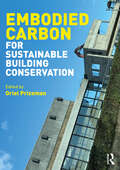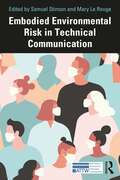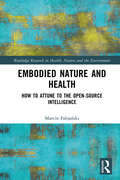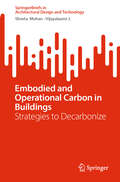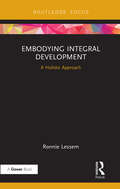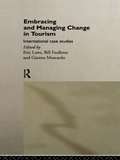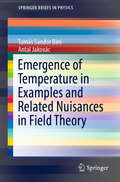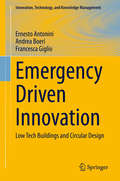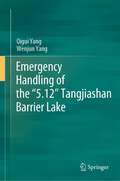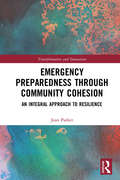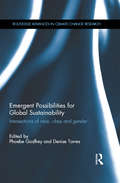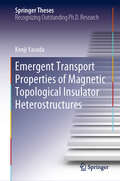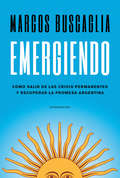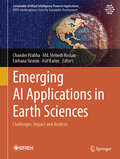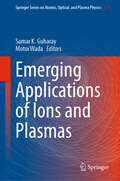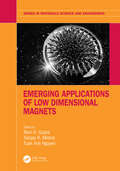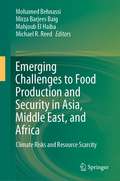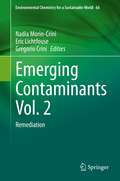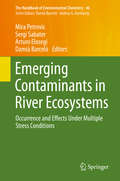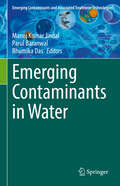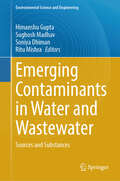- Table View
- List View
Embodied Carbon for Sustainable Building Conservation
by Oriel PrizemanThis timely volume provides the latest research, guidance, examples, and methods for understanding, calculating, leveraging, and reducing embodied carbon in building conservation. In the context of climate change and increasing energy costs, imperatives to replace or substantially modify older and historic buildings are rapidly accelerating. The idea that a new or replacement building will perform better overlooks the embodied carbon of that which it replaces. In effect, the pressures of one conservation agenda, that of energy efficiency, threaten to eclipse another, that of heritage. The embodied carbon of existing buildings must be addressed if calculations of operational energy use are to be properly balanced.In this book, an international and multi-disciplinary group of authors offer perspectives on the influence and implementation of strategies to account for embodied carbon for the conservation of the historic environment. Examples are deliberately diverse and extend beyond buildings to the valorisation of a heritage grassland landscape specifically because of its capacity to store carbon, to the fundamental attributes of historic concrete and our responsibility to consider replacement with critical care.This book inspires confidence in developing arguments by spreading examples globally and delivering plausible, actual narratives alongside clear up-to-date guidance. It brings together international standard-setters with practitioners, academics and advocates, all clearly explained. It also illustrates how embodied carbon played a pivotal role in seeking to determine the case of saving Marks and Spencer, Oxford Street, London, from replacement. This will be an essential resource for all building conservation and heritage practitioners including building surveyors, architects, conservators, engineers, conservation officers, building archaeologists and consultants.
Embodied Ecology: Yoga and the Environment
by Christopher Key ChappleIn Embodied Ecology, Hindu Studies scholar Christopher Key Chapple explores how Hindu and Yoga traditions can inform contemporary discourse about the problems of environmental degradation both in India and globally.What do Hinduism and Yoga philosophy have to say about ecology and the environment? Christopher Key Chapple provides an in-depth analysis of the traditional texts and ideas that relate to modern concerns and conversations in the environmental movement. Chapple explains what ancient Indian texts, including the Vedas and Upani?ads, tell us about the centrality of earth-awareness in early India. Chapple then also examines how contemporary eco-activists, such as Vandana Shiva, M.C. Mehta, and Sunderlal Bahuguna, are applying traditional teachings and methods to current environmental crises. Embodied Ecology highlights how Hindu and Yoga ideals can address pressing environmental problems including global consumerism, the proliferation of plastic waste, species extinctions, and climate change. Chapple offers insights on how Yoga ethics can help us create guidelines for the modern ills of over-consumption and how meditation practices can help foster a greater connection to the environment, as well as alleviate distress brought about by eco-anxiety. Under Chapple&’s guide, students will gain familiarity with primary Hindu texts describing methods for understanding and connecting with the five primary elements and learn Yoga practices and lifestyle changes that can be applied to bring about positive change on both a global and individual level.
Embodied Environmental Risk in Technical Communication: Problems and Solutions Toward Social Sustainability (ATTW Series in Technical and Professional Communication)
by Samuel StinsonThis collection calls for improved technical communication for the public through an embodied, situated understanding of environmental risk that promotes social justice. In addition to providing a series of chapters about recent issues on risk communication, this volume offers a diverse look at methodological practices for students, researchers, and practitioners looking to address embodied aspects of crisis and risk that incorporate UX, storytelling, and dynamic text. It includes chapters that bring embodiment to the forefront of risk communication, highlighting the cycle of content creation, dissemination, public response and decision making, continuing iterations of educational efforts, and recovery, toward increasing adaptive capacity as a whole. In addition, this work directs necessary attention to overcoming perceptual difficulties, memory lapses, definitional differences, access issues, and pedagogical problems in the communication of risks to diverse publics. This collection is essential reading for scholars and can be used as a supplemental text or casebook for courses in technical communication, environmental communication, risk and crisis communication, science communication, and public health.
Embodied Geographies (Critical Geographies)
by Elizabeth Kenworthy TeatherEmbodied Geographies provides a comprehensive account of different types of life crises which develop our identities and affect how we live our lives. Chapters focus on:* pregnancy, childbirth, teenagers and parenthood* migration* the threat and reality of violence* illness and disability* bereavement, the ensuing family responsibilities and death itself.It includes case studies from the UK, Australia, New Zealand, Singapore, Hong Kong, Canada and the USA.
Embodied Nature and Health: How to Attune to the Open-source Intelligence (Routledge Research in Health, Nature and the Environment)
by Marcin FabjańskiThis book describes how, as a species our survival and capacity to flourish depends on realizing the intimate relationship of humans with nature through active, embodied participation with nature. Living within the physicality of the planet is not a limitation, rather it is our liberation. Full realization of the consequences of this relationship, through embodied action, can liberate us from ego-dependence and transform us into a community of interdependent and flourishing beings. Embodied Nature and Health: How to Attune to the Open-source Intelligence describes a systems analysis of presence-centered cultivation of well-being through particular ways of being physically and mentally active in relation to nature that aims at helping the individual attune to natures’ rhythms. The systems analysis proposes the hypothesis of the Open-source Intelligence: an intelligence which originates from the placement of individual organisms in the tissue and the process of life. This framework draws upon and integrates contemporary research into the human–nature relationship and human well-being, and ancient philosophies that were developed prior to the Cartesian gap between the mind and the body, as well as using an auto-ethnographic approach dervied from the experience of the author. The proposed system highlights a practical approach to well-being, based on research into human attention and its effective usage in daily life. The book outlines a methodology that can be used in schools, as a basis of training in sports, as well as in the field of self-development, and highlights the necessity to develop a new, non-abusive relationship with the natural environment. This novel, multi-discipline, first-of-its-kind research book will be of strong interest to experts and academics in the fields of physical activity, education, ecology, and philosophy.
Embodied Time: Temporal Cues in Built Spaces
by Kevin NuteThe word time occurs more than seven times as often as space in written English, yet in the design of the indoor environments where we now spend most of our lives these priorities are typically reversed, with time often being little more than an afterthought. Embodied Time endeavors to correct that imbalance by demonstrating how built environments can be designed to evoke positive recollections of the past, interactions with the present, and anticipations of the future.
Embodied and Operational Carbon in Buildings: Strategies to Decarbonize (SpringerBriefs in Architectural Design and Technology)
by Vijayalaxmi J. Shveta MohanThis book offers the basics of embodied and operational carbon while discussing the inclusion of carbon emission in the GBRS at global and national level. This book also critically explores the important topic of embodied and operational carbon of buildings with insights on the strategies to measure and reduce embodied carbon in buildings through a case study and application approach. This approach assesses the impact of embodied carbon on the choice of structural systems, alternate building materials, alternate building technologies and air conditioning system. The impact of these alternate measures in reducing embodied and operational carbon is analyzed by demonstrating its use on a base case building, which is similar to an existing office building in India. The quantified data enables architects and designers to make early design decisions for a more environmentally sensitive approache to sustainable building designs. This book is a valuable resource for students, researchers, and practicing architects in understanding evidence based repercussions of structural systems, use of materials, technology and air conditioning systems to design green and sustainable buildings.
Embodying Integral Development: A Holistic Approach (Transformation and Innovation)
by Ronnie LessemIn this fourth and final volume of the CARE-ing for Integral Development series, Ronnie Lessem integrates all that has come before in terms of: Community activation; Awakening integral consciousness; and institutionalized Research. Here he focuses on individual and community development alongside that of the organization or society, and sets it in the context of an integral economy. The four critical success factors identified in recognizing and releasing integral development aligned with CARE are: GROUNDING – linking up with and building upon existing local and global movements for socio-economic development; EMERGENCE – maintaining interconnected focus; NAVIGATING – locating and developing GENE-ius in a particular community/society; EFFECTING – committing to resolving an issue and identifying the most fertile development path. Embodying Integral Development offers a comprehensive system of accreditation. Supported by examples and illustrations of CARE, this book makes a case for Integral Development as a whole. It argues that it is a qualitative means of self-assessment rather than a quantitative one, focused on engagement, immersion and interpretation, as well as evaluation, rather than empirical verification.
Embracing and Managing Change in Tourism: International Case Studies
by Gianna Moscardo Eric Laws Bill FaulknerEmbracing and Managing Change in Tourism examines management responses to the major changes taking place in international tourism and considers tourism itself as an agent of change. Including twenty-two detailed case studies from around the world this book explores two key principles. Firstly that change is enevitable and, if effectively managed, has the potential to benefit all those living in, working in and visiting the destination. Secondly, that there are no universal prescriptions for the effective management of change in tourism, since each destination has distinguishing characteristics and the nature of the problems facing it change over time.
Embracing the Future, Powering Growth: An Energy System Renewed for China (Advances in Oil and Gas Exploration & Production)
by Shell International B.V. Development Research Centre of the State Council (DRC) of People’s Republic of ChinaTo build a new energy system is the key towards China's goal of carbon emissions peak and achieving carbon neutrality. The new energy system will reshape the conventional energy system in an integrated and revolutionary way. It will not only bring about major changes in energy production, utilization and consumption, as well as emissions of greenhouse gas (GHG) and local pollutants, but also have profound implications on technological innovation and economic development. Based on quantitative and systematic analysis, this study depicts the energy system by 2030 and by 2060, analyzes the impacts of the energy system on economic and social development, studies and judges the key risk points, and proposes the path and policy system for building a new energy system.This is an open access book.
Emergence of Temperature in Examples and Related Nuisances in Field Theory (SpringerBriefs in Physics)
by Antal Jakovác Tamás Sándor BiróField theory, relying on the concept of continuous space and time while confronted with the quantum physical nature of observable quantities, still has some fundamental challenges to face. One such challenge is to understand the emergence of complexity in the behavior of interacting elementary fields, including among other things nontrivial phase structures of elementary matter at high energy density or an atypical emergence of statistical properties, e.g., when an apparent temperature is proportional to a constant acceleration in a homogeneous gravitational field. Most modern textbooks on thermal field theory are mainly concerned with how the field theory formalism should be used if a finite temperature is given. In contrast, this short primer explores how the phenomenon of temperature emerges physically for elementary fields - inquiring about the underlying kinetic field theory and the way energy fluctuations and other noise should be handled - and it investigates whether and how this harmonizes with traditional field theory concepts like spectral evolution, the Keldysh formalism, and phase transitions.
Emergency Driven Innovation: Low Tech Buildings and Circular Design (Innovation, Technology, and Knowledge Management)
by Ernesto Antonini Andrea Boeri Francesca GiglioThis book explores the relationship between the circular economy and the building technologies within the quintuple helix innovation model. The main question the book answers is whether and how the conversion of sustainable construction processes can be a powerful engine of innovation for the industry. The post-disaster settlements and temporary shelters are assumed as examples of what can be defined as circular buildings in regards to the technical arrangements and features, material and process reversibility, as the social and participative dimensions.Several cases of these interventions are documented and classified by three thematic axes: design, building and living. This highlighted new trajectories for innovation in building technology, consistent with the social, economic and productive dynamics that no longer allows for growing performance by increasing the resource demand. A theoretic framework is traced supporting this vision, which shows how the low technologies can respond to the transition of the economic model from linear to circular. Within this trajectory, the low-tech design for remanufacturing represents a reference framework and a promising tool applicable to the building processes.The enabling technologies and new paradigms for the transition to circular economy emerging from the European research scenario are also mapped, outlining z`the possible future developments in line with open technical and societal challenges.
Emergency Handling of the “5.12” Tangjiashan Barrier Lake
by Qigui Yang Wenjun YangThis book introduces emergency management of barrier lakes systematically,including theories and practices, risk assessment under extremely high-riskconditions, evolution of outburst floods, analysis of anti-impact stability, andemergency management technology and assessment of risk elimination effect.It takes the Tangjiashan barrier lake as a successful case study toillustrate effective treatment of barrier lake with high risks, poor environmentalconditions, extremely urgent rescue time and high disposal difficulties. Itretains a large number of images and data of great research value for the lakerisk assessment and building technological emergency system. It provides areliable reference for the government, scientific researchers and survey anddesign team to deal with the sudden natural disaster in barrier lakes,especially caused by huge earthquake.
Emergency Preparedness through Community Cohesion: An Integral Approach to Resilience (Transformation and Innovation)
by Jean ParkerThis book is a revision of the author’s original doctoral thesis on emergency preparedness through community radio in North Indian villages into a widening array of possible reapplications in other community development fields. The author expands on the process of transforming emergency preparedness education through community media in rural North India and applies this to the development of community-prosperity, defined simply as human and planetary well-being, anywhere in the world. A new theoretical framework is presented which combines the pivotal Integral Worlds Approach developed by Lessem and Schieffer with Critical Theory, thus exploring a new way to envision and implement social change, leading to innovation and social transformation. This book introduces the term "constructive resilience," which is a type of community-building that occurs alongside dominant societal structures that are either oppressive or ineffective. An evolving field of study and practice, it is emerging from the work of academics and community-builders who are members of the Bahá’í Faith. Bahá’í "consultation," a process of inquiry and decision-making, is offered as a systematic and effective method of defining problems and enacting solutions and is examined in the context of emergency preparedness education and local capacity-building. With its integral development approach, its unique combination of themes and theoretical components, and integration with the Bahá’í Faith, as well as its interdisciplinary nature, this book will be invaluable reading for researchers in many fields. It will be of particular interest in university-based training programs in disaster management and the various disciplines of international community development, as well as practitioners in the areas of micro enterprise, disaster management, community development, rural communications, rural economics and emergency preparedness education.
Emergent Possibilities for Global Sustainability: Intersections of race, class and gender (Routledge Advances in Climate Change Research)
by Phoebe Godfrey Denise TorresIt must be acknowledged that any solutions to anthropogenic Global Climate Change (GCC) are interdependent and ultimately inseparable from both its causes and consequences. As a result, limited analyses must be abandoned in favour of intersectional theories and practices. Emergent Possibilities for Global Sustainability is an interdisciplinary collection which addresses global climate change and sustainability by engaging with the issues of race, gender, and class through an intersectional lens. The book challenges readers to foster new theoretical and practical linkages and to think beyond the traditional, and oftentimes reductionist, environmental science frame by examining issues within their turbulent political, cultural and personal landscapes. Through a variety of media and writing styles, this collection is unique in its presentation of a complex and integrated analysis of global climate change and its implications. Its companion book, Systemic Crises of Global Climate Change, addresses the social and ecological urgency surrounding climate change and the need to use intersectionality in both theory and practice. This book is a valuable resource for academics, researchers and both undergraduate and post-graduate students in the areas of Environmental Studies, Climate Change, Gender Studies and International studies as well as those seeking a more intersectional analysis of GCC.
Emergent Transport Properties of Magnetic Topological Insulator Heterostructures (Springer Theses)
by Kenji YasudaThis book reveals unique transport phenomena and functionalities in topological insulators coupled with magnetism and superconductivity. Topological insulators are a recently discovered class of materials that possess a spin-momentum-locked surface state. Their exotic spin texture makes them an exciting platform for investigating emergent phenomena, especially when coupled with magnetism or superconductivity. Focusing on the strong correlation between electricity and magnetism in magnetic topological insulators, the author presents original findings on current-direction-dependent nonreciprocal resistance, current-induced magnetization reversal and chiral edge conduction at the domain wall. In addition, he demonstrates how the coupling between superconductivity and topological surface state leads to substantial nonreciprocal resistance. The author also elucidates the origins of these phenomena and deepens readers’ understanding of the topologically nontrivial electronic state. The book includes several works which are published in top journals and were selected for the President’s Award by the University of Tokyo and for the Ikushi Prize, awarded to distinguished Ph.D. students in Japan.
Emergiendo: Cómo salir de las crisis permanentes y recuperar la promesa argentina
by Marcos BuscagliaMarcos Buscaglia analiza en detalle la peor crisis de la historia argentina (2018-2020) y propone un conjunto articulado y sólido de reformas para que el país encuentre su rumbo y comience a emerger del subdesarrollo dando lugar a una nueva república, superadora de la conservadora y de la peronista. La Argentina atraviesa el peor momento de su historia al tiempo que los argentinos, que parecemos capaces de naturalizarlo todo, sin objetivos ni aspiraciones comunes, empezamos a desdibujar nuestra identidad como sociedad. Marcos Buscaglia describe aquí, con detalle y profundidad inéditos, la crisis 2018-2020, pero va mucho más allá: presenta una visión, un camino para empezar a emerger. La salida tiene que ver con la economía y con la política, claro, pero también con la ciudadanía y la cultura porque, en última instancia, de lo que se trata es de valores. Poco piadoso y preciso en el reconocimiento de nuestras inconsistencias, valiente y sólido en el enunciado de las reformas necesarias, entusiasta y esperanzado en el potencial argentino, este libro propone la construcción de una nueva república, superadora tanto de la conservadora como de la peronista. El mensaje es claro: con vocación de futuro y voluntad de éxito, si los argentinos nos ponemos de acuerdo sobre el rumbo, no habrá obstáculo difícil de sortear. Porque no podemos permitir que nos gane el caos, conforme empecemos a andar, iremos dejando en el pasado nuestra historia de desencuentro y fracaso recurrentes. Entonces sí, finalmente, estaremos emergiendo.
Emerging AI Applications in Earth Sciences: Challenges, Impact and Analysis (Sustainable Artificial Intelligence-Powered Applications)
by Md. Mehedi Hassan Farhana Yasmin Chander Prabha Asif KarimThis proposed book provides deeper insights into artificial intelligence techniques and procedures available for earth sciences. This book unveils several applications of metaheuristic approaches (i.e., swarm intelligence and IoT technologies) in collaboration with AI for earth sciences. It presents the science behind smart technologies that reveal the power of artificial intelligence and IoT. These methodologies help to extract meaningful insights from earth sciences big data analytics. These advanced technologies used in earth science practices can remove geographical barriers, locally adaptive, operationally feasible, and economically affordable. The areas can be explored with the aim of digitizing the whole world. Technological advancement also impacts the financial aspect involved in managing the earth sciences. Intelligent AI applications have made significant strides in the field of earth sciences, offering novel solutions to complex challenges, driving impactful research, and revolutionizing data analysis and interpretation. This intersection of artificial intelligence and earth sciences has paved the way for an enhanced understanding of our planet and its various phenomena.
Emerging Applications of Ions and Plasmas (Springer Series on Atomic, Optical, and Plasma Physics #127)
by Samar K. Guharay Motoi WadaThis book discusses recent advances in the science and technology of charged particles and emerging frontiers in applications of ions and plasmas. In particular, this includes: ion/plasma interactions with soft matters, especially, interrogating local bio cells, bio systems, liquids and gels; interactions with ambient environments; processes associated with fine-scale characterization of materials, materials modification, new material discovery, and above all, plasma chemistry. The book takes a broad view of the underlying problems with a distinct aim to engage young researchers and even advanced undergraduate and beginning graduate students. The first few chapters discuss relevant broad science issues covering ions and plasmas as well as methodologies for their manipulations; in addition, mathematical and computational tools for analysis are highlighted through simple examples. This background knowledge, in turn, develops a solid foundation for the chapters on numerous emerging application areas. A balance between science and engineering, along with relevant computational modeling, simulation, and exploitation of data, is maintained throughout. Prospective outlooks for the future are discussed. Overall, this book offers a lens for the reader to get acquainted with active and fruitful emerging application domains for future explorations.
Emerging Applications of Low Dimensional Magnets (Series in Materials Science and Engineering)
by Sanjay Mishra Ram K. Gupta Tuan Anh NguyenLow-dimensional magnetic materials find their wide applications in many areas, including spintronics, memory devices, catalysis, biomedical, sensors, electromagnetic shielding, aerospace, and energy. This book provides a comprehensive discussion on magnetic nanomaterials for emerging applications. Fundamentals along with applications of low-dimensional magnetic materials in spintronics, catalysis, memory, biomedicals, toxic waste removal, aerospace, telecommunications, batteries, supercapacitors, flexible electronics, and many more are covered in detail to provide a full spectrum of their advanced applications. This book offers fresh aspects of nanomagnetic materials and innovative directions to scientists, researchers, and students. It will be of particular interest to materials scientists, engineers, physicists, chemists, and researchers in electronic and spintronic industries, and is suitable as a textbook for undergraduate and graduate studies.
Emerging Challenges to Food Production and Security in Asia, Middle East, and Africa: Climate Risks and Resource Scarcity
by Mohamed Behnassi Mahjoub El Haiba Mirza Barjees Baig Michael R. ReedThis book, as a part of a series of CERES publications, provides a multi-regional and cross-sectoral analysis of food and water security, especially in the era of climate risks, biodiversity loss, pressure on scarce resources, especially land and water, increasing global population, and changing dietary preferences. It includes both conceptual research and empirically-based studies, which provides context-specific analyses and recommendations based on a variety of case studies from Africa, Middle East, and Asia regarding the fostering of long-term resilience of food and water security. The core approach of the volume consists of: assessing the structural drivers affecting the vulnerability of food and water security, under the persistence of current trends; identifying the best solutions and practices to enhance the climate resilience for food and water security; and fostering climate adaptation and biodiversity protection for food and water security.
Emerging Contaminants Vol. 2: Remediation (Environmental Chemistry for a Sustainable World #66)
by Eric Lichtfouse Grégorio Crini Nadia Morin-CriniEmerging contaminants are chemical and biological agents for which there is growing concern about their potential health and environmental effects. The threat lies in the fact that the sources, fate and toxicology of most of these compounds have not yet been studied. Emerging contaminants, therefore, include a large number of both recently discovered and well-known compounds such as rare earth elements, viruses, bacteria, nanomaterials, microplastics, pharmaceuticals, endocrine disruptors, hormones, personal care products, cosmetics, pesticides, surfactants and industrial chemicals. Emerging contaminants have been found in many daily products, and some of them accumulate in the food chain. Correlations have been observed between aquatic pollution by emerging contaminants and discharges from wastewater treatment plants. Most actual remediation methods are not effective at removing emerging contaminants. This second volume presents comprehensive knowledge on emerging contaminants with a focus on remediation.
Emerging Contaminants in River Ecosystems
by Sergi Sabater Damià Barceló Mira Petrovic Arturo ElosegiThis volume offers an overview of the occurrence of emerging organiccontaminants in Mediterranean rivers and their relevance to their chemical and ecologicalquality under water scarcity. With chapters covering the effects under multiple stressconditions of pharmaceuticals, polar pesticides, personal care products, and industrialchemicals, the observations presented can be applicable to other parts of theworld where water scarcity is an issue . It is of interest to environmentalchemists, ecologists, environmental engineers, and ecotoxicologists, as well aswater managers and decision-makers.
Emerging Contaminants in Water (Emerging Contaminants and Associated Treatment Technologies)
by Manoj Kumar Jindal Bhumika Das Parul BaranwalThis book provides comprehensive information on emerging contaminants in water, their sources, detection techniques, ecological and health impacts, and sustainable mitigation strategies. It emphasizes the urgent need for research and global collaboration to ensure the safety and sustainability of water resources. These emerging contaminants include per- and polyfluoroalkyl substances (PFAS), microplastics, pharmaceuticals, personal care products, pesticides, industrial and household products, metals, surfactants, industrial additives, radioactive elements and many more which pose potential risks to ecosystems and human health. While extensive research has explored their individual effects, there remains a critical gap in understanding their combined ecological impacts. Recent research underscores various contaminants' harmful effects, prompting efforts to develop new and more efficient removal techniques. While methods like adsorption and filtration show promise, biological methods offer a promising alternative with greater degradation efficiency. This book comprises all such information related to emerging contaminants in water systems and what could be the next step to mitigate their harmful impact in a sustainable manner. The book is structured into seven parts, covering the classification, sources, detection techniques, occurrence, ecological and health effects, and fate of key contaminants like microplastics and PFAS in aquatic ecosystems. It also explores mitigation strategies, including setting safe thresholds and implementing sustainable removal approaches. Through an in-depth review of current research and future directions, this book serves as a valuable resource for scientists, policymakers, and environmental professionals working toward mitigating the harmful impact of emerging contaminants on water systems. Chapter 5 is available open access under a Creative Commons Attribution 4.0 International License via link.springer.com.
Emerging Contaminants in Water and Wastewater: Sources and Substances (Environmental Science and Engineering)
by Himanshu Gupta Sughosh Madhav Ritu Mishra Soniya DhimanThis present book serves as a comprehensive compilation of various emerging contaminants in the ecosystem, their contamination risk as well as the applicable remediation techniques. Exploding urbanization and industrialization often combined with improved standards of living have resulted in deleterious effects on the quality of the environment. Due to rapid growth of industrialization in the past few decades, large amounts of undesirable wastes are being discharged into the environment threatening the survival of living beings on the earth. In the recent years, the problems regarding pollution have become more global, and awareness about the environmental problems is increasing continuously. Environmental awakening has led many scientists to focus on the assessment of environmental impact of various emerging contaminants. The first victims of the environmental pollution are the terrestrial plants and aquatic bodies in the vicinity of urban areas that experience heavy pollution due to industrial effluents, toxic chemicals, hospital waste, radioactive waste, industrial fumes, vehicular traffic, etc. The increasing industrialization and use of hazardous chemicals are responsible for the lack of access to clean water in many parts of the world. In view of the widespread occurrence, persistence, and harmful effects of environmental pollutants on human population, the present book is proposed. Emerging contaminants due to ubiquitous distribution, persistence, and toxic effects have necessitated the development of efficient methods for remediation of contamination. Reports appearing from time to time reveal that the number and concentration of contaminants in the environment are continuously increasing. Thus, development as well as dissemination of new and eco-friendly methods for the removal of these pollutants has become a challenging task.
